Impressions of Kerala and Theyyam
 Having been in Kerala for a few days now (albeit only one very small part) I guess I have some impressions. The Kannur region, where I am staying is very different from anywhere I've been in India. The thing that has really struck me and Tanya is the amount of huge mansions (that put to shame some of the grandest Sydney sea-side houses) we've seen in all of the villages we've visited. This is not a poor man's region and not seeing at least a few mud houses, or at least small houses in a village, it feels almost un-Indian. There is a lot of development taking place in the region - lots of fast food chains, even a few shopping centers, again this is rather new for me, because Kannur is not even a big city. Could the communist government of Kerala be responsible for all this 'prosperity'? We ran across a Russian couple, who are staying at a beach resort 15km away from where I am. The resort owner is a very proud member of the communist party and when we met he raved on about how great communism has been in Kerala. Unfortunately, when he asked about the way communism was in Russia we couldn't match his enthusiasm, to which he responded - Well maybe it was different over there, here it is great! This development, the huge mansions, the communism - I am still trying to get my head around it all, I'd like to come across someone who can give me a more accurate understanding of everything. One thing for sure, for a photographer like myself, who tries to capture ancient culture and traditions Kannur town is no place to be, but I have simply based myself here for a few days to photograph the Theyyam.
Having been in Kerala for a few days now (albeit only one very small part) I guess I have some impressions. The Kannur region, where I am staying is very different from anywhere I've been in India. The thing that has really struck me and Tanya is the amount of huge mansions (that put to shame some of the grandest Sydney sea-side houses) we've seen in all of the villages we've visited. This is not a poor man's region and not seeing at least a few mud houses, or at least small houses in a village, it feels almost un-Indian. There is a lot of development taking place in the region - lots of fast food chains, even a few shopping centers, again this is rather new for me, because Kannur is not even a big city. Could the communist government of Kerala be responsible for all this 'prosperity'? We ran across a Russian couple, who are staying at a beach resort 15km away from where I am. The resort owner is a very proud member of the communist party and when we met he raved on about how great communism has been in Kerala. Unfortunately, when he asked about the way communism was in Russia we couldn't match his enthusiasm, to which he responded - Well maybe it was different over there, here it is great! This development, the huge mansions, the communism - I am still trying to get my head around it all, I'd like to come across someone who can give me a more accurate understanding of everything. One thing for sure, for a photographer like myself, who tries to capture ancient culture and traditions Kannur town is no place to be, but I have simply based myself here for a few days to photograph the Theyyam.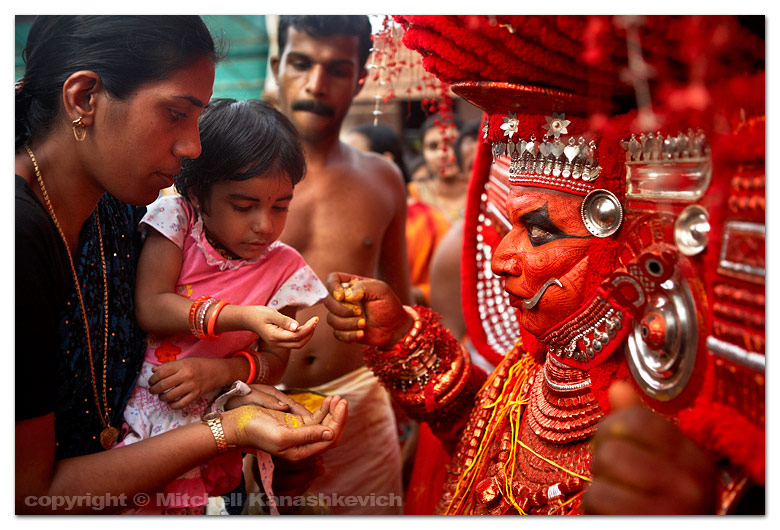 Photographing the Theyyam has been fascinating and frustrating. Fascinating because, well I think the images suggest why, and frustrating for several reasons. First there are crowds and then there are crowds of local photographers who battle for a good angle, not something I'm used to, since I rarely come across 'likeminded individuals' on my photographic quests. The next source of frustration comes from the fact that Theyyam is a deeply religious performance, in fact Theyyam means 'God' in the local language and so while the artist is performing he is basically a deity. When photographing such performances without much knowledge (learning on the spot from the fellow photographers who sometimes get reprimanded for pushing past anyone and anything) one has to tread carefully, not to offend anyone. Of course you could say that I could be better prepared and learn more about what I'm photographing, but not so. I have learned about the principal ideas and the history, however there are more than 400 Theyyam performances which are somewhat different from each other, not only that, the performances take place in different temples all the time and that means that the degree of restrictions is variable. On any given day I do not even know which Theyyam I'll be photographing.
Photographing the Theyyam has been fascinating and frustrating. Fascinating because, well I think the images suggest why, and frustrating for several reasons. First there are crowds and then there are crowds of local photographers who battle for a good angle, not something I'm used to, since I rarely come across 'likeminded individuals' on my photographic quests. The next source of frustration comes from the fact that Theyyam is a deeply religious performance, in fact Theyyam means 'God' in the local language and so while the artist is performing he is basically a deity. When photographing such performances without much knowledge (learning on the spot from the fellow photographers who sometimes get reprimanded for pushing past anyone and anything) one has to tread carefully, not to offend anyone. Of course you could say that I could be better prepared and learn more about what I'm photographing, but not so. I have learned about the principal ideas and the history, however there are more than 400 Theyyam performances which are somewhat different from each other, not only that, the performances take place in different temples all the time and that means that the degree of restrictions is variable. On any given day I do not even know which Theyyam I'll be photographing.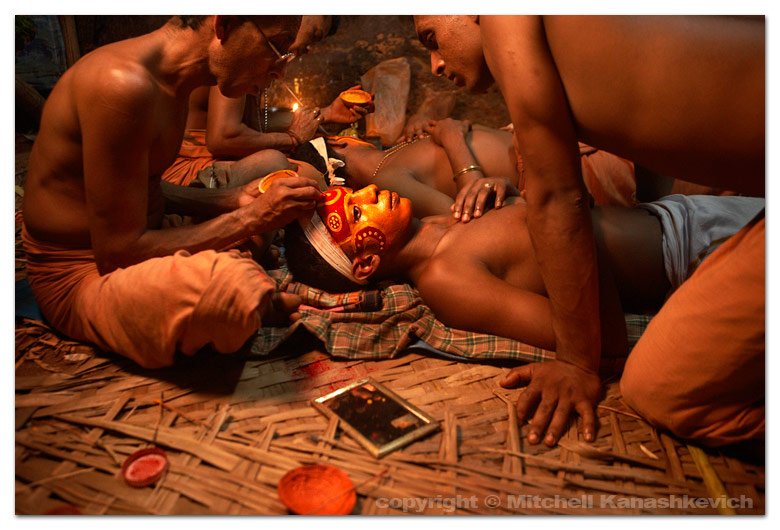
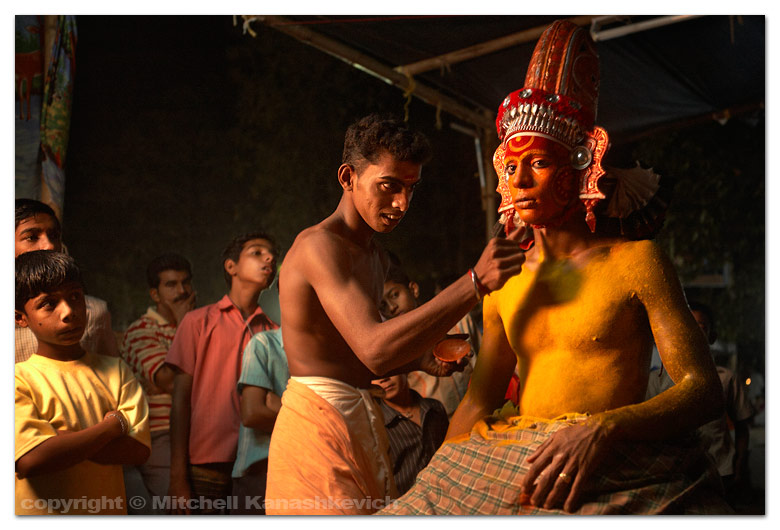 The first Theyyam the "Muhcilot" left me rather unimpressed, performance wise. In short it consisted of an elaborately dressed plump artist circling the temple and murmuring something in what I later found out to be a mixture of Sanskrit, Old Malayalam and Tamil (south Indian languages). Then the devotees rushed in, blessings were given and money started pouring in from all directions, so much money that it had to be put into baskets to be carried away. This went on for over two hours and as I later found out (I couldn't bear staying any longer) it would go into the night, until all of the devotees were blessed.
The first Theyyam the "Muhcilot" left me rather unimpressed, performance wise. In short it consisted of an elaborately dressed plump artist circling the temple and murmuring something in what I later found out to be a mixture of Sanskrit, Old Malayalam and Tamil (south Indian languages). Then the devotees rushed in, blessings were given and money started pouring in from all directions, so much money that it had to be put into baskets to be carried away. This went on for over two hours and as I later found out (I couldn't bear staying any longer) it would go into the night, until all of the devotees were blessed.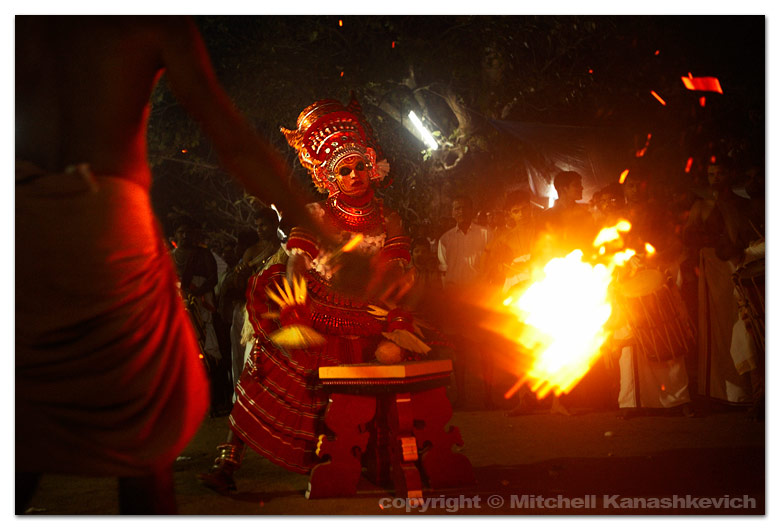
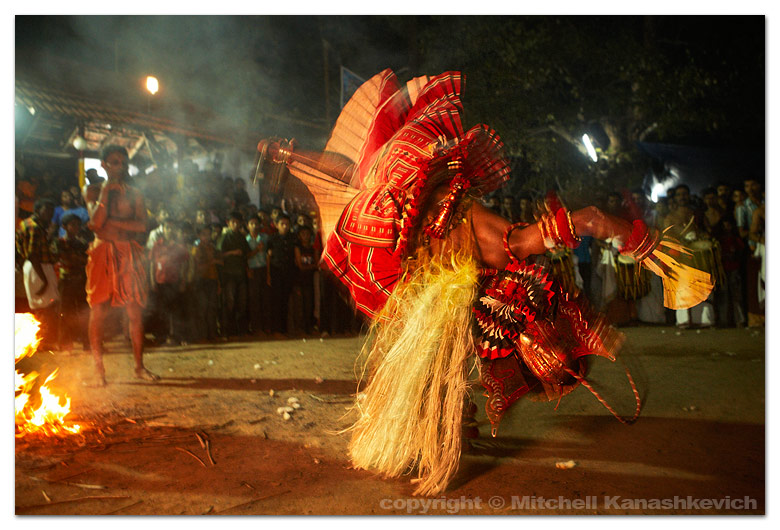 The second Theyyam was the same as the first and rather than watch it I decided to head to the Kerala Folklore Academy, to learn whether there was more to Theyyam than what I had seen. The photos on the walls of their small museum and a very brief conversation with a very-busy-overtime-working Theyyam expert left me with the belief that indeed there was much more to Theyyam. The very next night I would see just how much more. Upon arriving at another village temple I unknowingly befriended a young Theyyam artist who spoke basic English. When I found out who he was and who the small group of young men with him were (all Theyyam artists) I asked if I could photograph them while they put on their makeup and get dressed, they agreed. I photographed the whole process and then, suddenly the temple drummers began to beat a dramatic tune, the last elements of the costume were in place and the artist, as if possessed by a wild beast, jumped from his make up chair and rushed into the temple. His performance would be a stark contrast to the monotonous stuff I had seen earlier. There was fast, loud, dramatic drumming, fire, summersaults and cartwheels. The next Theyyam performance was even more impressive, with more of the same content, executed in an even more dramatic manner. The whole thing was pretty amazing, the atmosphere, the crowd's reaction and of course the Theyyam itself. Tanya and I definitely felt the magic in the air.
The second Theyyam was the same as the first and rather than watch it I decided to head to the Kerala Folklore Academy, to learn whether there was more to Theyyam than what I had seen. The photos on the walls of their small museum and a very brief conversation with a very-busy-overtime-working Theyyam expert left me with the belief that indeed there was much more to Theyyam. The very next night I would see just how much more. Upon arriving at another village temple I unknowingly befriended a young Theyyam artist who spoke basic English. When I found out who he was and who the small group of young men with him were (all Theyyam artists) I asked if I could photograph them while they put on their makeup and get dressed, they agreed. I photographed the whole process and then, suddenly the temple drummers began to beat a dramatic tune, the last elements of the costume were in place and the artist, as if possessed by a wild beast, jumped from his make up chair and rushed into the temple. His performance would be a stark contrast to the monotonous stuff I had seen earlier. There was fast, loud, dramatic drumming, fire, summersaults and cartwheels. The next Theyyam performance was even more impressive, with more of the same content, executed in an even more dramatic manner. The whole thing was pretty amazing, the atmosphere, the crowd's reaction and of course the Theyyam itself. Tanya and I definitely felt the magic in the air.
There is much more to Theyyam, the story behind it is quite fascinating and while I will probably write much more about it in the future, for the moment there is no time to share this on the blog. However, if anyone's interested here's a website that goes into a bit of depth about Theyyam: www.theyyam.com
Now to the photos. Tanya and I wanted to see whether we could manage to work our two person team with an off camera flash for the images taken after dark. It worked great for the make-up part. A gel was placed over the flash to warm the light and then a portable softbox, to make that light less harsh. Again I simply wanted to simulate natural light - a candle, or a warm light bulb - whatever doesn't strike one immediately as a harsh flash. Without the flash there would be no images or they's be horrendous. If I were to use a 1/20 Shutter speed I could have possibly come up with something visible, but very flat and that wouldn't do justice to the 'subject'. This two person set-up of ours works nicely in a relatively small or a closed off space and when the line of vision is maintained between the IR flash remote and the flash. Different story when the line of vision is lost - the person with the flash has to twist the flash sensor towards the camera and has to remain parallel or a little in front of the camera. If not - the flash will simply not go off. Very frustrating, but that's the price to pay for not using the radio transmitter systems. On the plus side - I do not look like I have a walkie-talkie on top of my camera and I attract a little bit less attention then I would have otherwise.